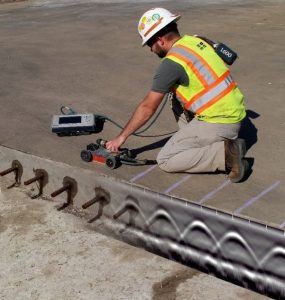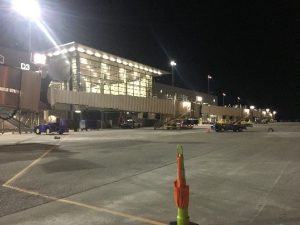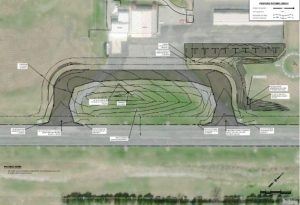February 24, 2022
Airport Pavements
 Every day, more than 2.9 million airline passengers and 45,000 flights take off in the United States.
Every day, more than 2.9 million airline passengers and 45,000 flights take off in the United States.
More than half of all Airport Improvement Program funds are allocated to constructing or rehabilitating airport runways, taxiways, and aprons. Federal Aviation Administration (FAA) pavement standards help protect this investment, setting guidelines based on years of research and testing, so that pavements last as long as possible with routine maintenance.
What is unique about airport pavement?
The FAA has performed rigorous testing on various pavements and developed specifications for concrete pavement (P-501) and asphalt pavement (P-401). FAA specifications for airfield pavements are more rigorous than standard highway pavement specifications. Airfield pavements must be designed to bear the loads imposed by aircraft without failure, be economical to construct and maintain, and have a typical twenty-year life expectancy.
More specifically, airport pavements typically:
- Have a larger percentage of asphaltic binder material
- Require stricter gradation of the aggregate to help bind the coarse aggregate and fill the gaps
- Have a tighter mix that is less permeable for stormwater infiltration
- Require smoothness testing, grade requirements, and profilograph testing for acceptance
Why does designing, maintaining, and repairing airport pavement matter?
Safety is the number one priority for designing, maintaining, and repairing airport pavement. If pavement cannot withstand the load of an aircraft, the failure could be catastrophic. Cost is an important factor to consider as well. As pavements age, failures could lead to unwarranted costs in damage to aircraft, slips, trips, or falls of airport personnel. Lastly, airports must maintain accessible runways, taxiways, and aprons pavements for a proper landing.
What’s Under Your Pavement?
 Aircraft loads can have a detrimental effect on airport pavements. As airplane sizes increase, so does the aircraft’s weight, creating more challenges for pavement. The FAA estimates that airports in the United States handle roughly 44,500,000,000 pounds of freight each year. The heavier aircraft stresses the runway, taxiway, and apron pavements that far exceed typical roadway pavement stresses.
Aircraft loads can have a detrimental effect on airport pavements. As airplane sizes increase, so does the aircraft’s weight, creating more challenges for pavement. The FAA estimates that airports in the United States handle roughly 44,500,000,000 pounds of freight each year. The heavier aircraft stresses the runway, taxiway, and apron pavements that far exceed typical roadway pavement stresses.
Pavements experiencing failure typically show signs of wear and tear by fragmenting or breaking away of pieces of pavement; excessive longitudinal cracking extending several feet throughout the pavement; or separating at joints to create gaps in the pavement exceeding 1” wide.
Geophysics
Geophysics uses specialized non-invasive technologies to measure and identify differences in the physical properties of materials such as pavement, concrete, soil, and rock.
One technique of geophysics is Ground Penetration Radar (GPR). GPR allows design and geotechnical engineers to view a graphical interpretation of the airport pavement subgrade with minimal disturbance. Our experts identify different substrates under the pavement or proposed pavement area to identify where, what, and how an investigation should proceed to provide optimal benefit.
Read more about GPR and the benefits of this specialized technique.
S&ME civil engineers and designers evaluate data from GPR and Geotechnical Investigation to develop an approach for pavement rehabilitation, reconstruction, or maintenance. Following FAA, State, and Local regulations to foster a precise plan for achieving an airport’s goal, S&ME’s aviation design services team works to advance the design phase seamlessly into the construction phase. Our team of aviation, pavement, environmental and geotechnical engineers, in conjunction with our material testing professionals, allows for an interdisciplinary approach to an aviation project.
S&ME Aviation Project Spotlights
Nashville International Airport (BNA), Concourse D
Nashville, TN
 This 110,000 square foot concourse addition to the terminal provides six additional gates to the terminal building and 36,000 square feet of additional TSA security lanes and baggage claim conveyor systems to accommodate the growth in passengers.
This 110,000 square foot concourse addition to the terminal provides six additional gates to the terminal building and 36,000 square feet of additional TSA security lanes and baggage claim conveyor systems to accommodate the growth in passengers.
Amongst other services, our team worked with a GPR survey crew, hired by the contractor, to identify underground utilities to work around the jet fuel lines and other lines.
Colonel Tommy C Stiner Airfield
Jacksboro, TN
 S&ME is working for Campbell County and the Colonel Tommy C Stiner Airfield – Campbell County Airport to design the replacement of the aging existing stake-mounted incandescent lighting system with new base can-mounted LED lights. In addition, the current bullhorn taxiway system will be replaced with 90-degree angled taxiways to connect the existing apron with the runway. Relocation of the tie-downs will require expansion of the existing apron. The expansion of the apron required GPR investigations to identify an underground drainage channel that was emanating from under the pavement and daylighting on the slope. The design of the pavement section for the apron expansion will coordinate and accommodate the underground drainage to redirect the source of the drainage into the nearest catch basin.
S&ME is working for Campbell County and the Colonel Tommy C Stiner Airfield – Campbell County Airport to design the replacement of the aging existing stake-mounted incandescent lighting system with new base can-mounted LED lights. In addition, the current bullhorn taxiway system will be replaced with 90-degree angled taxiways to connect the existing apron with the runway. Relocation of the tie-downs will require expansion of the existing apron. The expansion of the apron required GPR investigations to identify an underground drainage channel that was emanating from under the pavement and daylighting on the slope. The design of the pavement section for the apron expansion will coordinate and accommodate the underground drainage to redirect the source of the drainage into the nearest catch basin.
The project will provide the necessary airplane movements when entering the runway and will expand the existing apron to add multiple aircraft tie-downs that will be removed during the realignment project.
Contact Us
For more information on S&ME Aviation services, please contact Area Manager, John Weavil, PE.

